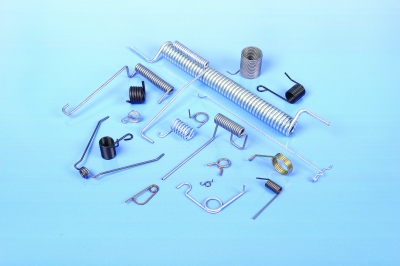E-spring
Vehicle suspension has always relied on conflicting requirements such as; passenger comfort, road holding and load carrying, to be in balance. This intricate balance has long been a contentious issue for engineers. Suspension springs are designed to absorb shock from the road by compression and extension when bumps are encountered.
The spring rate has a large impact on the performance of a vehicle in relation to these factors. A low spring rate can increase passenger comfort, but at the detriment of the other factors and a high spring rate with a heavy load causes excessive bumps. Variation in spring rate, therefore, would be a great aid to vehicle suspension.
Such a concept has been created in the by Cambridge postgraduate researcher Salah Elmoselhy’s concept of the E-spring.
The concept behind the E-shaped spring is that it can offer the variation needed in spring rate to give the best experience for both passenger comfort, road holding and load bearing. The unique shape means that some sections flex easily under light loads whilst another can increase the stiffness as the load increases.
Such a shape avoids undue stress and can contribute to the longevity of the spring and thus improve vehicle performance. Further improvements to suspension can be made the more E-springs that are used.
There are many benefits that the new E-spring can bring to car suspension. Weight reduction of up to 80% can lead to a long-term reduction of fuel consumption, making vehicles more efficient. It also means that there is a much-reduced space requirement, leaving more room for safety equipment and other such necessities.
The compact space of the E-spring means that variable loads can be moved and passenger comfort never has to be sacrificed. This, removes the need for hydraulic dampeners and improves the overall fatigue performance of vehicles.
The scalability of this spring also means that it can be used in items as small as semiconductor chips for smarter technology.
[edit] Find out more
[edit] Related articles on Designing Buildings Wiki
Featured articles and news
Infrastructure that connect the physical and digital domains.
Harnessing robotics and AI in challenging environments
The key to nuclear decommissioning and fusion engineering.
BSRIA announces Lisa Ashworth as new CEO
Tasked with furthering BSRIA’s impressive growth ambitions.
Public buildings get half a million energy efficiency boost
£557 million to switch to cleaner heating and save on energy.
CIOB launches pre-election manifesto
Outlining potential future policies for the next government.
Grenfell Tower Inquiry announcement
Phase 2 hearings come to a close and the final report due in September.
Progress from Parts L, F and O: A whitepaper, one year on.
A replicated study to understand the opinion of practitioners.
ECA announces new president 2024
Electrical engineer and business leader Stuart Smith.
A distinct type of countryside that should be celebrated.
Should Part O be extended to existing buildings?
EAC brands heatwave adaptation a missed opportunity.
Definition of Statutory in workplace and facilities management
Established by IWFM, BESA, CIBSE and BSRIA.
Tackling the transition from traditional heating systems
59% lack the necessary information and confidence to switch.
The general election and the construction industry
As PM, Rishi Sunak announces July 4 date for an election.
Eco apprenticeships continue help grow green workforce
A year after being recognised at the King's coronation.
Permitted development rights for agricultural buildings
The changes coming into effect as of May 21, 2024.






















